Team Australia Wins The Worrell 1000 Reunion Race 2019
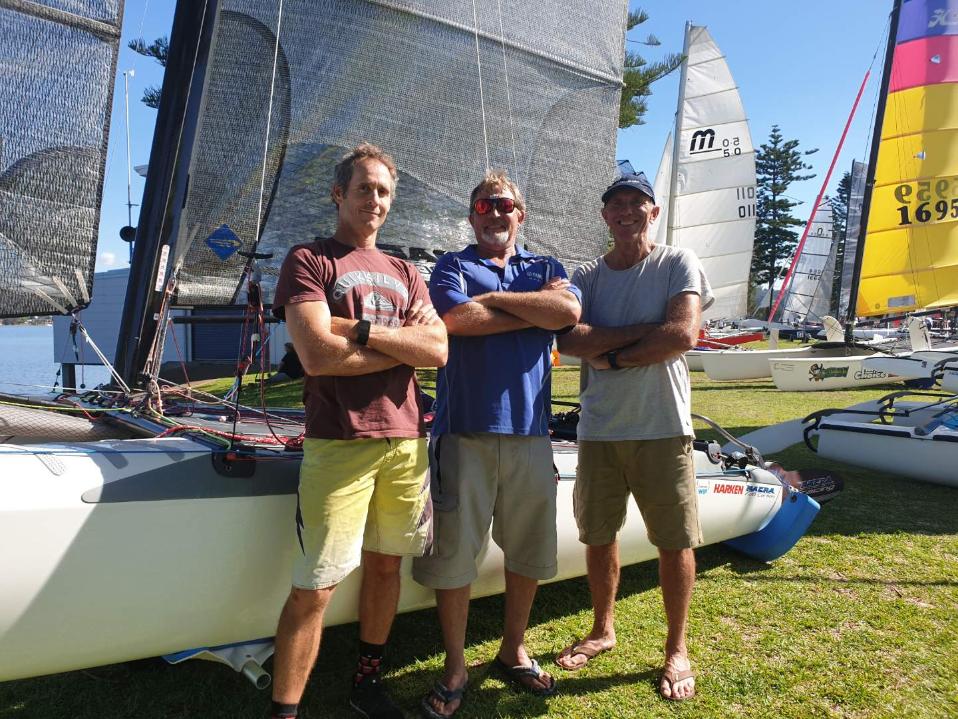
Team Australia Worrell 1000 2019, left top right: Beau White, Brett White and Rod Waterhouse
When Rod asked them to join him in sailing the 13 day catamaran stage race up the east coast of the United States there was only one answer that would suffice.
Rod Waterhouse sailed with 3 different crews in this race in 2001, but sailed the majority of the legs with professional sailor Katie Pettibone in her first try at the Worrell 1000. Katie ranked it as challenging as the Volvo Ocean race. When asked how to prepare best for the race she replied, then, "Train Hard."
In 2001 the 11-time Worrell racer Rod Waterhouse was searching for a replacement for his injured crew, Sandra Tartaglino. When Waterhouse, a two-time winner, asked Pettibone to join his Team Guident, she was ecstatic. ''It was like Russell Coutts calling up to say he needed someone to help sail his America's Cup yacht,'' she said.
Waterhouse added to his legendary status when, approaching the beach at the end of the third leg with both his rudders broken, he lowered himself into the drink and used his lower torso as a human rudder to steer to safety.
Rod was effusive in his praise of Pettibone, but missed sailing partner Brett Dryland who was unable to sail in 2001. It was Rod and Dryland who had won this race twice.
The Worrell 1000 is a gruelling test of sailing skill, determination and toughness sailing a semi foiling 20ft off the beach catamaran 1000 miles. Team Australia, sailing a Nacra Carbon 20 seem up for the challenge.
To finish the Worrell 1000 a sailor must possess a unique blend of skills - they need to be a fast beach catamaran sailor in a wide variety of weather conditions, including heavy weather survival skills. They need to be incredibly fit. Being organised with logistics and having a steady hand with a tool is paramount.
Competitors choose to enter the Worrell 1000 for a wide variety of reasons; to race, while some just to try to finish. Some see the beauty in a sail up the barrier beaches of the South Atlantic coast, while all must see this as a chance to challenge themselves and learn more about how they will react to extremely trying conditions.
Race founder Mike Worrell said in 2001; "To me it's the personal challenge of doing something that puts yourself in danger where only your wits and ability to deal with your surroundings can assure your safety. Then overlay top competition and you've got an extreme sporting event similar to the Volvo Ocean race. I don't know why these people do it, but that's why I started it."
The race has always had an element of celebrating the beautiful places it passes through though. In 2019 the organisers state;
The Worrell 1000 Reunion Race, our Board, volunteers, and staff are dedicated to the principle of environmental stewardship. Our passion for beach catamaran racing brings us into direct contact with habitat and coastal environments that merit and require our personal involvement in restoration and preservation efforts. For the 2019 race, we’re working closely with local and state-level volunteer organizations at every checkpoint. Coordinated beach cleanup events are happening every day of the race to show the residents and businesses in these beach communities that we are grateful for their hospitality, and we’re good stewards of the ocean and shoreline along our route.
Our team is working, too, with the regulatory community and volunteer organisations dedicated to the protection and preservation of sensitive habitat. May is sea turtle nesting season, and since the first Worrell 1000 in 1974, we’re proud that we’ve successfully protected and helped preserve turtle nesting sites all along the Atlantic coastline. Hand-in-hand with local volunteers, we help mark and protect nests, and eliminate nighttime light sources that can negatively impact nesting habits in and near developed beach communities.
Monday, May 6, 2019 marked the start of the Worrell 1000 2019 Race and lucky Number 13 outing in a Worrell 1000 for Rod Waterhouse. As its name implies, this race - which takes the fleet of Nacra 20 and Formula 18 catamarans almost 1,000 miles from Hollywood, Florida, to Virginia Beach, Virginia - heralds back to the original Worrell 1000.
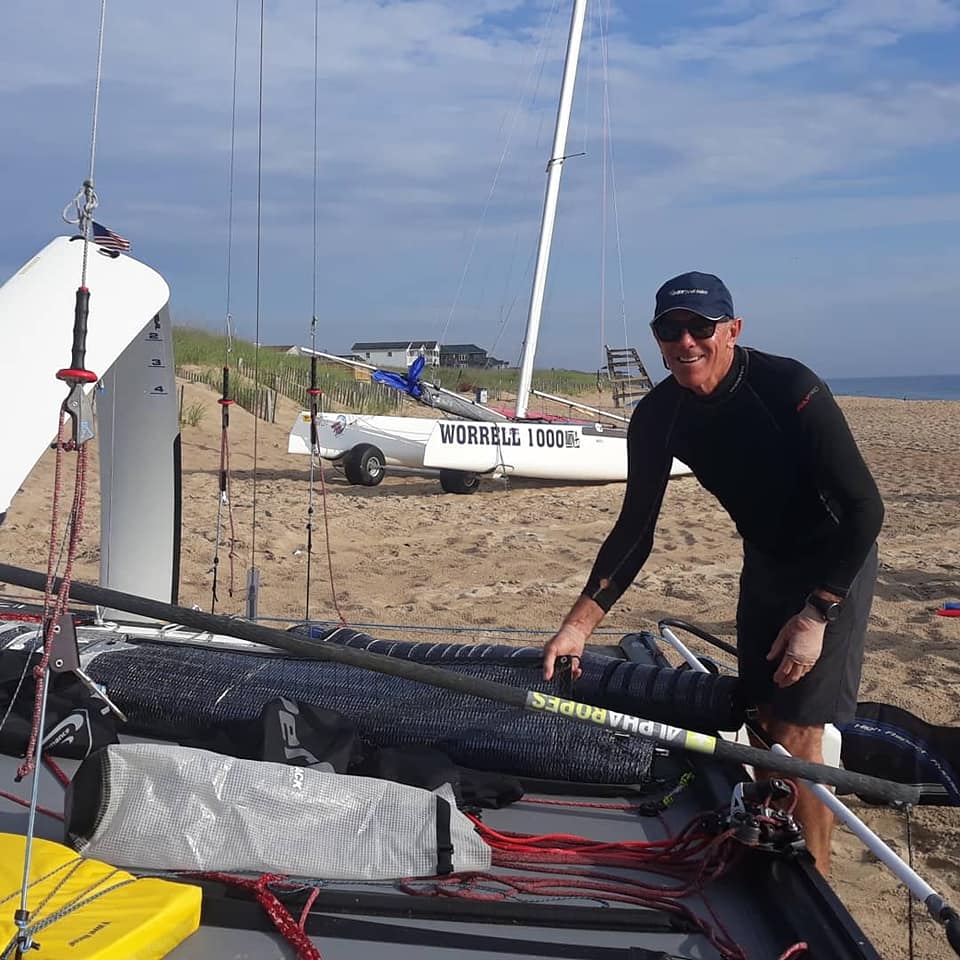
Rod Waterhouse - enjoying his 13th Worrell 1000
While it has been 17 years since the Worrell 1000 was last sailed, the 2019 Reunion Race attracted three teams intent on both finishing the full course and giving the course record (71 hours, 32 minutes and 55 seconds), established in 2002 by Brian Lambert and Jamie Livingston, a serious push.
As we go to press Team Australia sits in 1st place, with the final leg to go, on a time of 66:46:33, two hours of which are penalties incurred, one hour in the Tybee to Isle of Palms leg and the other in the Atlantic Beach to Hatteras sprint. The Aussies have placed 1st in each leg bar two - one placing them 2nd after one of those penalty hours and the other finishing just over one minute behind TCDYC.
During the earlier Worrell 1000's racers didn't have the benefit of electronics or modern search and rescue operations, but even now, 45 years later and loaded with modern technology, the challenge of racing small, open catamarans across almost 1,000 miles of North Atlantic ocean is just as challenging today as it was during the Worrell 1000's heyday.
The three teams, Cat in the Hat, TCDYC, and Team Australia, were on the final leg, with racers expected to cross the finishing line on Saturday, May 18th, US Time. At 6 a.m. Sydney time, May 19th, Team Australia finished first and took 1st place in the carbon class.
Worrell 1000 Reunion Race organiser's video of their finish this morning:
This race has always been contested aboard blisteringly fast but extremely fragile racing platforms so the race's founders wisely envisioned the Worrell 1000 as a series of point-to-point stage races, where racers sail hard on the water all day and then get the chance to sleep (or repair their boats) ashore each night.
At the 2019 Awards Ceremony in Virginia Beach, the Organising Authority announced that the next addition of the Worrell 1000 will be run in May of 2021. Classes eligible will be determined later in the year.
"We hope to see you on the line 05/03/2021 - Get your plans made!" they stated.
Worrell 1000 Reunion Race 2019 - final placings:
Team Boat Skipper Crew
1 Team Australia Nacra Carbon 20 Rod Waterhouse Beau White
2 Cat in the Hat Nacra Carbon 20 Larry Ferber Zack Panetti
3 TCDYC F18 Chris Green Christian Vuerin
Team Australia members Brett White, and Beau White, the gentleman who wrote that great report on the recent RPAYC Catamaran Invitational over the March weekend of 30th-31st, have been keeping fans up to date with videos, photos and reports on the special Team Australia Worrell 1000 2019 Facebook page.
Some of these posts and images:
Day 1 - The Worrell 1000 (NB: this is the day after son Jason Waterhouse won as party of the Australia SailGP Team at San Francisco) - visit: Australia Wins U.S. Debut of Sail GP
Today was 95% champagne sailing for us. 8-14 knt breeze, a near perfect prepared boat, Navigation gear 100%.
Yesterday Tech wizard Brett White put the final tweaks on Legend Tony's magnificent Nacra 20 Carbon FCS. The conversion to C boards complete, bigger spin blocks, rudders aligned and all the gear on the trampoline.
Safety equipment audits done, five hundred and thirty nine pages of liability waiver clauses signed by anyone who can draw breath.
Beau nearly had a nervous breakdown when the schmick new garmin quatix 5 would not accept a course and do its job. Three hours of app reinstalls and re-plotting of routes finally yielded results while Rod and Brett toiled away in the Florida heat getting the boat ready. A big job it was and Brett has been a genius!
Briefing was a social and fun affair with not too much detail and a few beers, well when you are sailing from A to B there's not much to say is there? Mike Worrell's wife made an appearance and is following us on the race. A moment of remembering the names of competitors and friends was held. Very touching when you realise how deep the relationships are that get formed during tough events such as these. The world is getting soft, there are so few teams here, hundreds of people are missing out on an event that can shape a lifetime.
Brett was back at work at dawn with Rod while supercrew and navigator extraordinaire Beau got some sleep. A major jet lag sufferer. Which is why this update is getting posted while Tech Brett gently snores on the bed.
So to the days racing!!!!
A standard sailing 5 minute start was had with the biggest blue peter flag in the world! We set off on the gun, well hooter mounted on a red esky that was super loud, ripped the kite up and went North pulling an early lead.
After two hours we could just see second place stalking us but as we were getting the hang of the Nacra 20 we started putting bigger numbers up on the speed GPS puk. The boat is magnificently fast and in the early light breeze we eased it from 12 knots to 17, to 19. As we got in the groove we stretched the lead. Rod and Beau took tuns on the tiller as they had lunch and both welcomed the break from concentrating on flying a hull for 2+ hours at a stretch or holding the kite.
At around 2:30 two enormous thunder storm cells developed. We headed toward shore for two reasons. 1. for safety and 2. to see if we could skirt the back of the big one and pick up more breeze.
As we gybed we picked up a huge header, Perfect! we narrowly slipped between the beach and the two converging storms complete with lightning bolts an all y'all.
There were some scary cloud formations and master of the Worrell, Rod commanded the kite to be dropped. After some questioning the instructions were followed and next thing bullets of breeze came out of nowhere.
We ripped along on squirts and puffs, two sailing away from the clashing two storms behind us and took a moment to thank Thor that we were not the boat behind. They would have to work their way trough that maelstrom and it was nasty.
A sprinkle of rain, one super weird hole in the breeze, a check on the Quatix watch and we were 23 NMiles away from the finish and zipping along again with a VMG of 17 knots.
We set a visual marker of a peach coloured building in the distance and made that the layline to then come to the beach and run along the beach to find the finish.
As we were approaching the beach, feeling rather chuffed with our efforts and ludicrously fast boat, a huge crowd grabbed our attention on the beach upwind of us. ARGGGH we have missed it! So we dropped the kite, for the second time in the day (Supercrew Beau was much annoyed at all this extra work) We headed back upwind. Only to find that it was a crowd having a tug-o-war and there were no orange Worrell 1000 flags flying. So, after some panicking in the shallows and a bump or two of the rudders in the shallows the kite was once again set and we headed to the peach building...where according to our charts and the quatics 5 we would find, people food and beer.
We duly arrived at the beach, blew the beach landing, threw the supercrew off the bow of the boat and dragged the carbon 20 up the beach.
It took a long time for the other boats to get through the storm and then the wind stopped with the last team getting in just before dark...a long long day for them.
Tomorrow another adventure awaits, thanks to our sponsors Legend Tony Priu, Rooster Sailing Gear, Harken and Forward Wip.
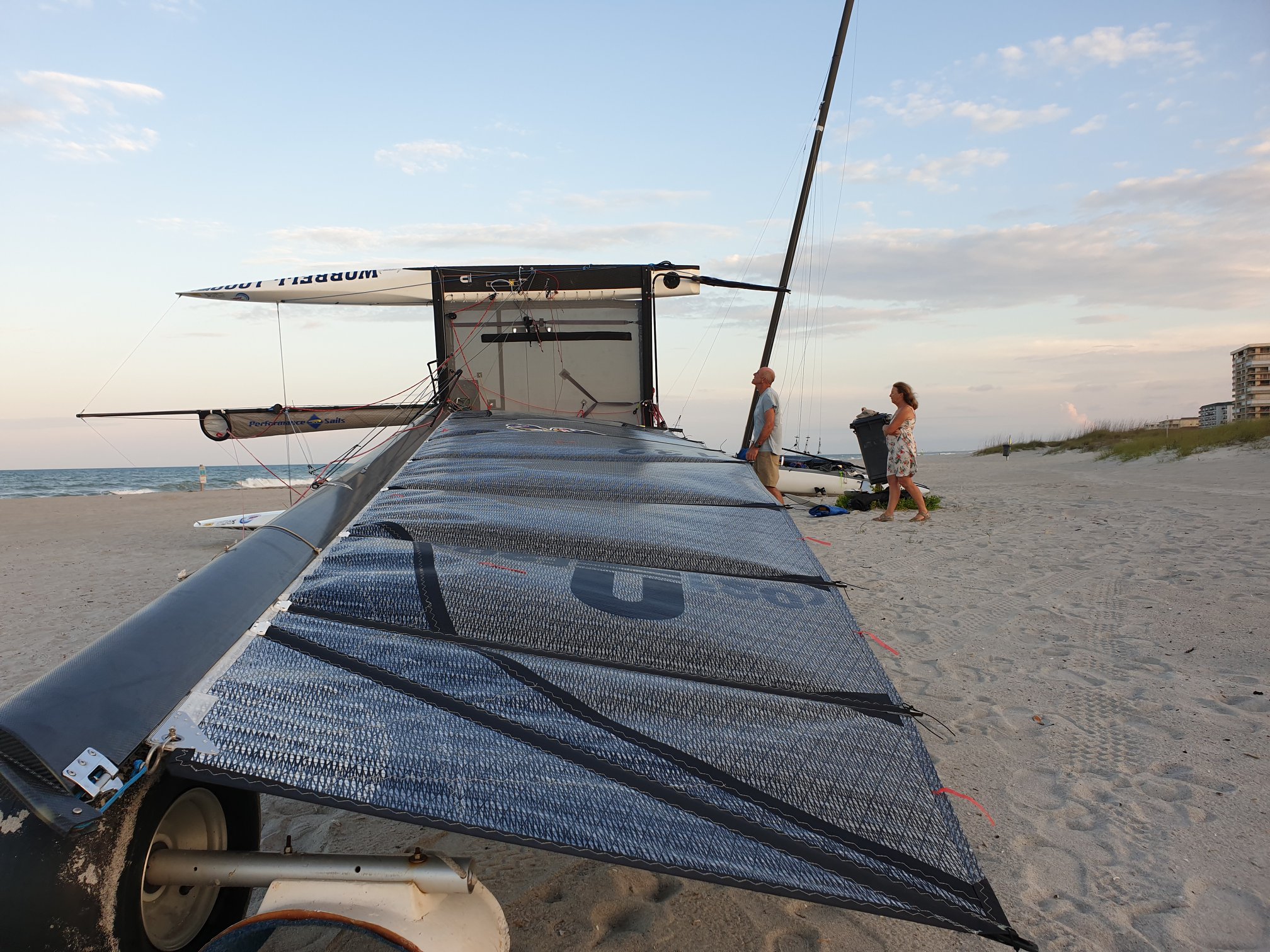
Rod and Kerry Waterhouse - photo by Brett White
_____________________________________
A grand tour of the coastal towns of the South.
Today, Saturday 11 May is the layday. Time to relax slow down and savour the situation and events. After a long and glorious sleep, the jetlag is finally under control, its time to recap so the days do not blur into each other where one cannot remember on which day what happened. Ultimately it all turns in to one emotional feeling inside, not the chronological series of events that lead to it, the details and reasons become tougher to recall as the days follow on each other.
The run from Cocoa Beach to Daytona was again blessed with excellent breeze and warm conditions. There was a heap of two sail reaching where you don’t know if you should be bearing away or twisting into the breeze to prevent the boat capsizing.
After some time we dropped into the “groove” and soon were holding 14-16 knots two sail reaching. Sea rocks (turtles) are a bit of an issue, they are fairly common and a massive dodging manoeuvre by Beau saved the centerboard from a bang and a sore turtle. Our stitching let go on the trampoline on the final spinnaker dowse. All was under control as Brett and Tony sipped delicious cold Yeunglings on the beach in Daytona while stitching the trampoline back together.
It was however another evening of hastened boat repairs and leak detection on the F18. Some borrowed dishwashing liquid from the pub and a hotel hairdryer on a loooong extension lead, showed a leak on the shroud tang of the F18 . Brett’s trusty black goop was once again called upon to Gum it up. We parked the boats in front of the Ocean Deck restaurant, who supplied great drinks, food and live music. Our hotel was located next to the Ocean deck and as Beau put his head down to sleep the familiar tune of men at work’s “Land Down Under” drifted across from the Ocean Deck into the hotel room, Brett was definitely getting things going in the pub.
The breeze blew all night and in the morning was still offering its moist warm goodness. Thursdays run to Jacksonville was set to be a downwind sled fest. We had permission from the brass at NASA to scoot as close to Cape Canaveral as we dared without whacking the centerboards off. Today there would be no machine gun toting helicopters and RIB's to spoil the fun. The direct onshore breeze made for a more technical start and was followed by a brief (ok relatively speaking) 9 NM upwind work to the Cape Canaveral point. This was made tougher by a huge crane being towed along the layline, which required some pinching much to Beau’s disgust and Rods stress levels. On arrival at the shallows we lifted the boards and tentatively slipped though the murky shallow waters at the cape.
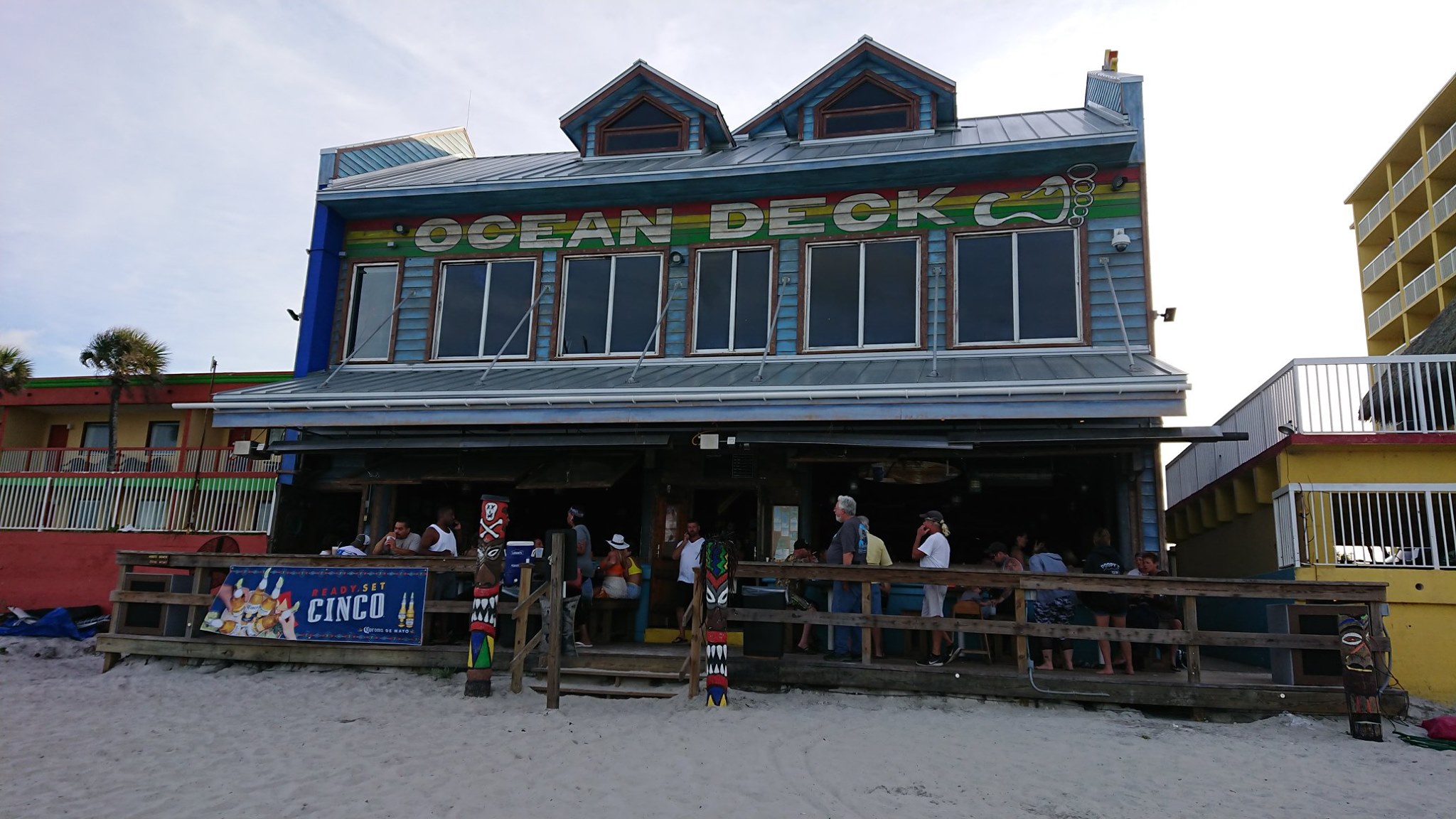
'One can easily spend a long long time here in Daytona' - Photo by Team Australia Worrell 1000 2019
We checked out the space ship launch scaffolding thingie and a rather flat point, nothing like North Head, Barrenjoey or Cape Point, more like Sydney airport on Botany Bay. After clearing the danger zone and the crumbling waves on the outer bank we pulled the kite up and worked hard to get some space between us and a very determined team Cat in the Hat who followed us through at the cape and seemed to be holding steady the distance we had made on the beat. We fiddled with the boat, pressed a bit harder and started making gains after a gybe back inshore out of the building chop.
This was the run where we posted the video that had us in our Rooster booties, jackets, gloves etc. and feeling like we were flying first class. All comfy, warm and tucked in. We almost expected a rather attractive air hostess to pop out from under the trampoline and offer us some champagne and canapés. Our new booties made the crew feel like spidermen. Now we could confidently move up and down the hull to balance the trim of the boat with our feet stuck to the hull like remoras. We LOVE ROSTER KIT! No more slipping on nose stuffs and getting washed off the back, YEAH MAN! My old boots and gear is relegated to huntin’ n fishin’ now. I may add, our southern drawl is getting better as we break into fluent (well what we think is fluent) southern swamp folk talk every few minutes. Such fun y’all!
We pressed the Nacra 20 harder and harder, with the exception of a rather eewie light spot at St Augustine. Here we were both in and low on the trampoline for a bit, working hard to keep the windward hull from slapping down and the boat above 12knots. Brett and Tony’s stitching was looking solid. We were mindful of the tide and worked the outgoing water from the estuary to maximum advantage by heading back in just at the right time.
Its quite an honour to sail with someone of the calibre of Rod. He seems to posses a sixth sense of the sea state, the thunder storms, breeze gradients, changes in air temperature and the movement of the water. Always mindful of conserving and not over pressurising the boat or the rigging but still working the boat for speed. Beau often needs to be reigned in from overcooking it and either breaking the boat or (as they say in the South) “us gettin’ our hats wet”.
The blast to Jacksonville was so fast the shore team did not even have time to sink a cold one before we hit the sand. It was a glorious day’s sailing and not much tougher than a morning of regatta racing with snacks on the way. Jacksonville could have been the lunch break and we would have done it again. We packed the boat and settled in for a few rather delicious Margarita’s at the hotel beach bar, struck up a conversation with some good ole southern boys and gals and discussed the merits of kiteboarding and sailing in such an idyllic location. Awesome!! And we don’t use that term lightly.
The F18 arrived with the whole aquarium in the port hull again, the leak on the stay tang was not the culprit. John, the ultimate PRO (sorry David) spotted a 10cm (4 inch in Southern) split in the seam of the hull forward of the centerboard case. Yes we fixed it, Larry (Cat in the Hat) bought resin, Team Texas got a generator, Beau filed and prepped the area, Tony sourced tools and mixing containers, Brett laid the glass in. A real team effort. Beau sat on the offending hull now finally patched, watching the dying light over the sea, Margarita in one hand, hair dryer in the other, warming the resin so it would set in the cooler moist air, contemplating life, opportunities taken and lost and how wonderful this race is.
Now! If you have been following the media, which if you are this far down the post you are more determined than most (well done for getting here by the way). You may be concerned by the technical failures that the boats seem to be having. Fear not. These boats are not breaking because it’s a tough race. They are breaking because they are not well prepped. Preparation is key, the maestro Rod knew this. He reached out the Brett because he knew Brett was the best man to get this boat ready and keep it perfect for the 12 days of sailing. Brett goes the extra mile and is meticulous about everything on the boat. Its all taped, double tied, bolted, torqued and safetied. If you arrive with a good boat, you only need to do little tweaks along the way, no more than a national or worlds type event.
The F18 and Cat in the Hat were needing heaps of work before the race started. Now admittedly not too many people want to take a brand new Carbon 20 and slide it up and down the beach. The Carbon 20 is certainly the ultimate weapon for this type of racing. You can however, do this race on a good secondhand F18 with a fit team and have the run of a lifetime. Yes afterwards you will need to spend a day to spray some gelcoat on the bottom of the hull and give it a sand and polish, but that should be it. Lift the boards early, be patient with the surf and you should only need to spend money on beer and margaritas. Both of which are in rich abundance at all the stops.
Thanks to the people that have assisted us and a massive thank you to Rooster Sailing kit and Simon at Life Aquatic for decking us out with what is truly the most fantastic gear. It’s a talking point on the boat, at meals and a joy to sail in.
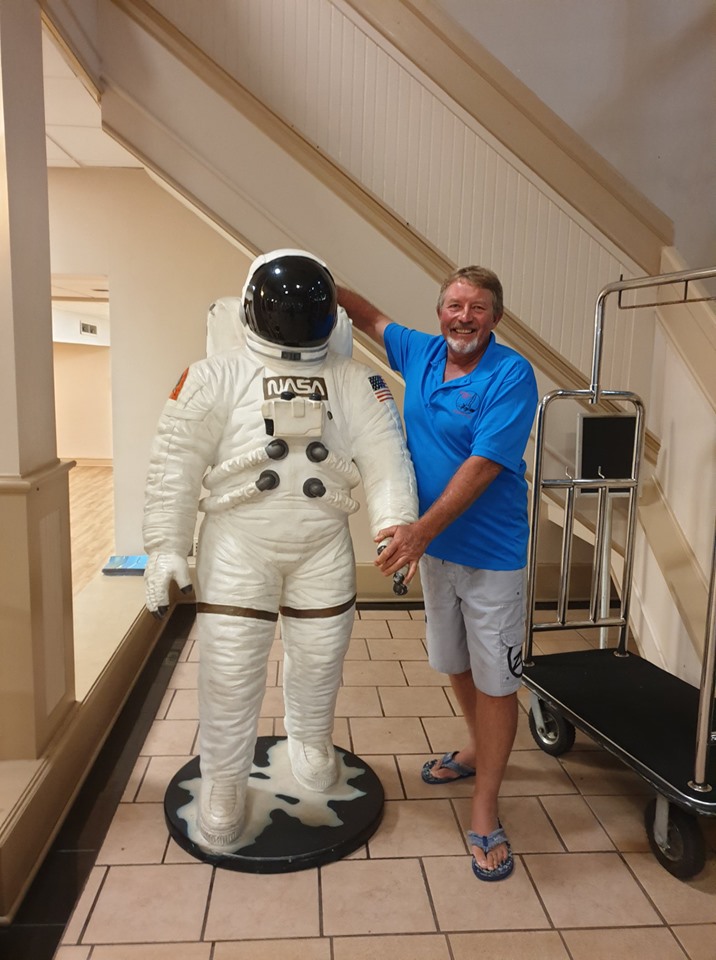
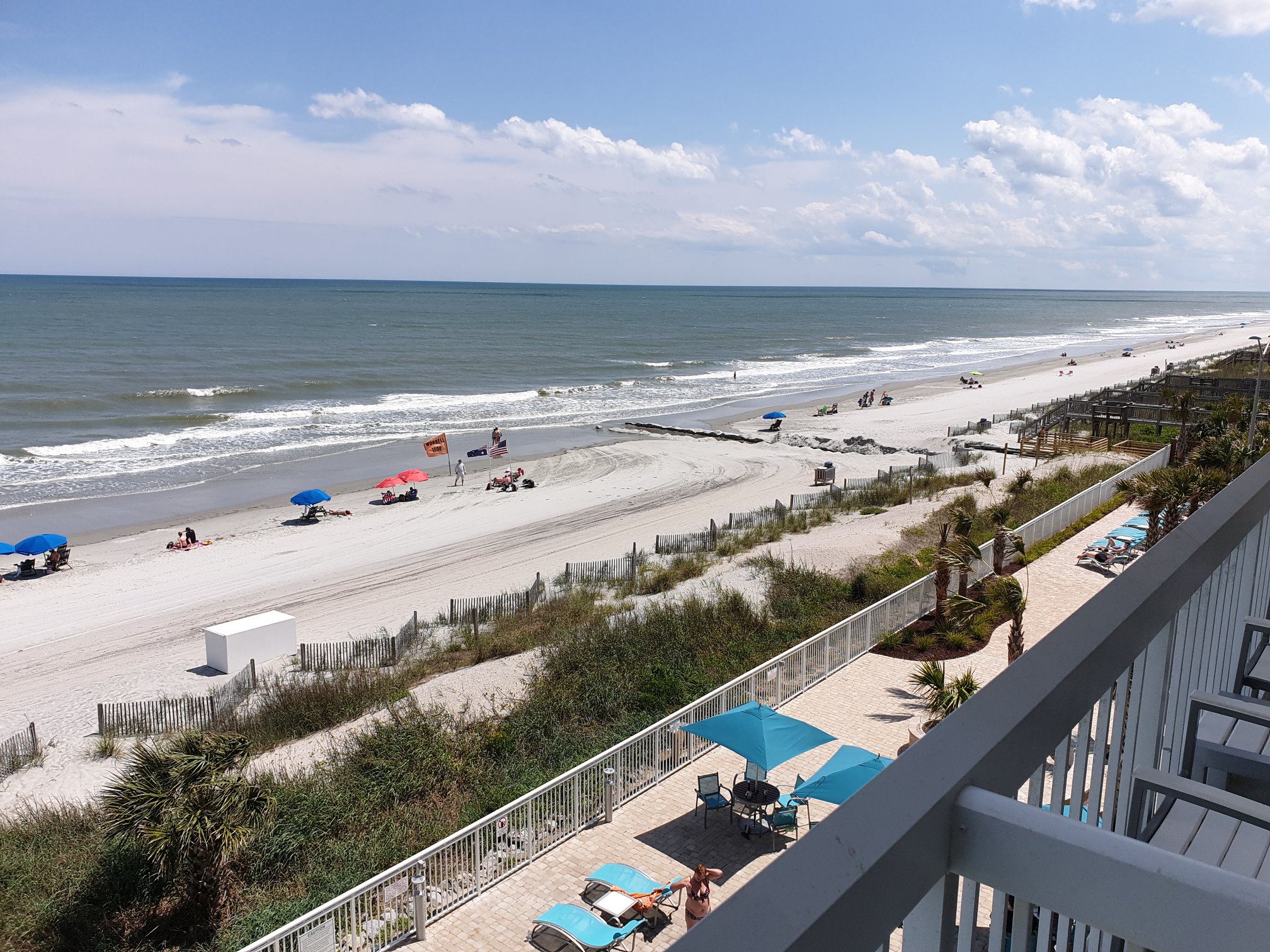
_____________________________________
The race continues..
May 14 (US) May 15 (AUS),2019
We are at Wrightsville Beach after a good race run, staying in a lovely hotel called the Blockade Runner. Listening to some Jack Johnson and John Mayer in the bar restaurant after a great meal.
A tough start in cooler conditions over short chop beating upwind that we just could not find our groove on. The competition doggedly chased us as we battered the Nacra into the chop. After an hour and a half of bashing and getting hosed and washed by the Atlantic the wind settled and twisted a bit behind us.
We pulled the kite and after a short time double stringed as high as the kite would pull us toward Cape Fear for the rather well respected crossing. The tack line today had a replaced trip system by Brett and Tony, all beautifully platted at the handle and was a work of art. The men are boat prepping machines!
These capes are really just large sand spits that stretch out perpendicular to the shoreline. The waves bend into them from both sides and I would imagine on a rough day would make the Nacra 20 have a tough time and bash the crew around - a lot! There are a few wrecks splashed out the places and Cape Fear has areas quite descriptively named the "Frying Pan Shoals" which I would imagine are tough on centreboards for the less cautious.
Today was a greaser though, we found the point on the chart really close in without too much hassle and slipped between two areas of breakers. One sneaky steep swell came out of nowhere and bounced us in the air, but that's about all the excitement we got.
After rounding the cape, Rod made the call to follow the beach as close as possible. It seemed counter intuitive as the breeze died initially on the shore, it was a puff session ranging from 3 knots to 20 with bullets of breeze slithering off the very quaint and pretty shoreline at varying angles. Beau almost pitched it in with a mad scramble to trip the traveller as we rose rapidly high above the water on the massively wide Nacra 20. After Rod god washed around the back after a wold beating teabag he remounted the beast not very impressed. We persevered for 23 NM to the finish with eyes out of the boat looking for the short sharp blasts charging at us..
The beach route paid and we put serious time into the competition even after our battles to shake them for the first hour.
Lots of media on the beach today with interviews, TV and promotions. We really hope this race gets the support it should, its the experience of a lifetime and just fantastic sailing.
Its getting cooler now and the Rooster gear is doing its job, Other teams were in dry suits but we managed fine in our super warm splash jackets, boots, full finger gloves and under garments. Thanks again to Rooster, Harken and Forward Wip and as always to the legend Tony Priu for such a magnificent boat. What a race!
_____________________________________
As of this writing, the three-strong fleet is on the last leg.
More information on the Worrell 1000 can be found at the website here: https://worrell1000race.com/
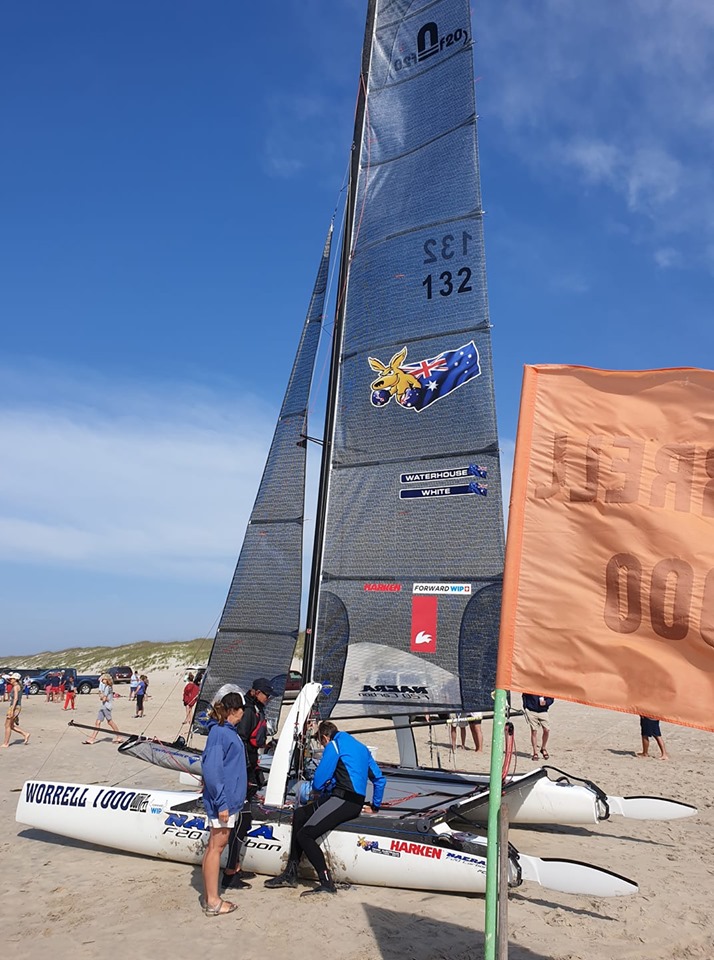
Ready for a big day to head out through the surf for the start. Photo by Team Australia Worrell 1000 2019
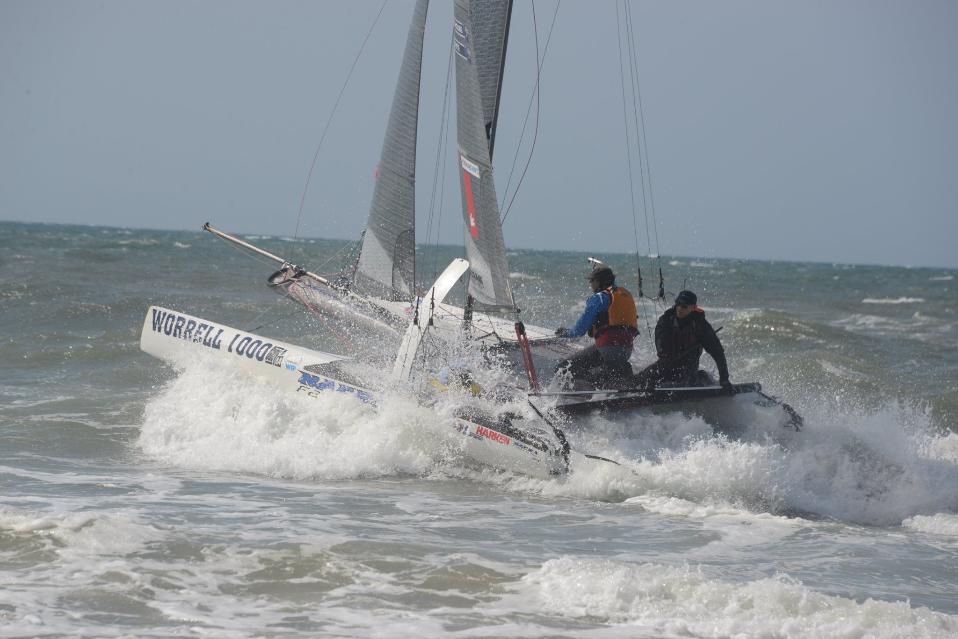
Team Australia launches into the surf at Hatteras on their way to Kill Devil Hills. Photo Credit: Robert L. Feldman
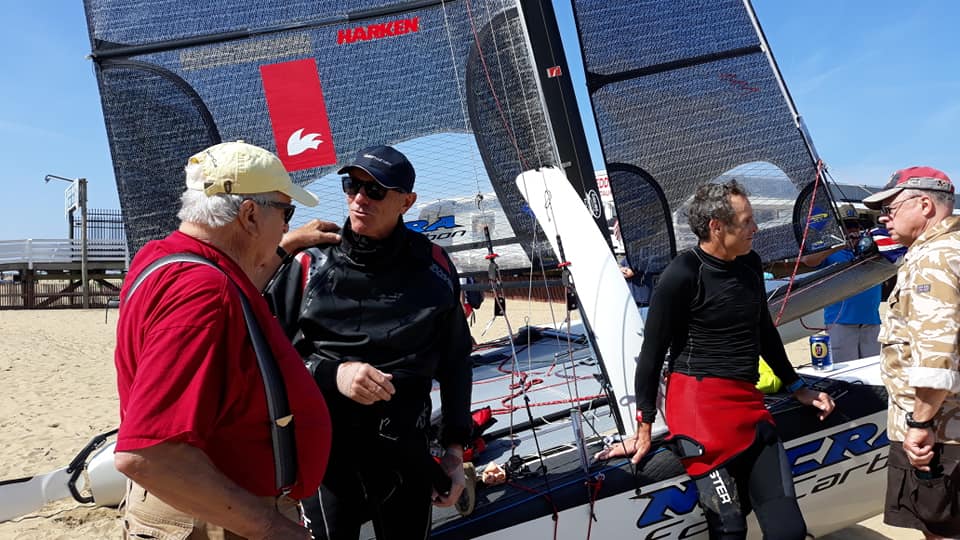
Rod Waterhouse and Beau White at the completion of their last leg, May 18th US Time, May 19th Sydney time.
Old School Worrell 1000...Some History
video by Boyd Tomkies
A race that was born of a barroom bet. In 1974 Chris Worrell, who owned a Virginia Beach restaurant with his brother, Michael, said that no one could sail a 16-foot catamaran from Virginia to Florida. Michael took the challenge, and after 20 days at sea (and two hurricanes) he came ashore in Fort Lauderdale and began to dream up ways to lure the world's best cat sailors into a contest of wills.
Worrell 100 Reunion 2019 and Background Information
A group of former participants have brought back this iconic race. While the three teams signed up for this marathon of man-in-a-small boat against Mother Nature pales from the event’s heyday, it’s a start.
“We realise it’s only three teams, but we know there are a lot of eyes on us,” said John Williams, a veteran of three Worrells and the event’s race officer in charge of the start and finish lines. “There has been a ton of online traffic and social media and we’ll be holding events at every stop.
There were going to be four teams, but Team Buoy 44 featuring the winner of the last two Worrells — Brian Lambert — at the helm pulled out at the last minute. Team captain Beetle Bailey said the logistics seemed too hefty and Lambert and crew member Will Rottgering decided to see how things went.
The Worrell 1000 was launched in 1976, the invention of Michael Worrell, who owned Worrell Brothers restaurant and bar in Virginia Beach with his brother, Chris. In 2002, Lambert and Jamie Livingston set the course record of 71 hours, 32 minutes and 55 seconds.
It would be the final race under Michael Worrell, who passed away on June 5th 2010, with the return to celebrate the challenge for which the race is born. The 13-stage event has daily legs with no breaks, with boats needing to launch from and finish on the beach, and scoring based on the best overall elapsed time.
On October 1, 1974, Michael and crew Steve McGarrett shoved off from the beach in front of the restaurant bound for Florida. After 20 days, two hurricanes, and numerous boat repairs, they made it as far as Fort Lauderdale before their catamaran succumbed to the rigors of the bet.
Intrigued by the challenge of the rugged trip, Worrell, who as a surfer, lifeguard, and later in business, had always been around the ocean, decided to raise the ante and create a radical new type of sailboat race.
The inaugural race, called "Worrell Bros. Coastwise Race", took place in May 1976. Four teams participated in the race. For that first race, limited to 16-foot hobie cats, there were very few rules. The participants could sail day and night, but they were supposed to come ashore and phone the restaurant once every 24 hours. The course was flipped with the start in Fort Lauderdale and the finish in Virginia Beach, to take advantage of the prevailing winds. The only team to finish the first race was that of Worrell and crew Guerry Beatson. 2 racers didn't make it past the Georgia, however the boat crewed by Peter Guthrie and Alan Kramer maintained the lead through Nags Head, N.C. Knowing they were well ahead they pulled ashore at the Nags Head pier to take a break. In the distance they saw a sail far to the south and ran to the beach to launch their boat for the final run to Virginia Beach. Unfortunately they did not realize how steep the surf was and when they attempted to launch in the high surf it overturned the boat and it broke apart allowing the Worrell and Benson to win. The inaugural race took 13 days to complete!
In 1979, Michael Worrell sold his half of Worrell Bros. to his brother Chris, who shortened the name of the race to Worrell 1000.[1] In 1985, the rules were changed to allow any boat within 20-foot length, 8-foot beam, instead of just hobie cats. In 1987, the rules were changed to allow unrestricted beam.[2] There was no race from 1990-1996, but it returned in 1997 as a production class event. For 2019, eligible classes are the Nacra F20 Carbon (in compliance with International Nacra F20 Carbon Class Rules dated 2011(Revsion 2018) and the Formula 18 ( in compliances with International Formula 18 Class Rules – F182019CR18012019-24657, dated 20JAN2019 and current and valid measurement certificate). Both referenced documents are available for download under the "Rules" page on the official website.[3] Boats must be able to launch from and finish on the beach.
References
- "About the Worrell 1000 Race". Worrell 1000.
- Michael Worrell. "The Race Director Looks Back". Worrell 1000.
- https://worrell1000race.com/sailing-instructions
- "Cat Sailor: Hall of Fame". Catsailor.com.
Results
Overall
Place Team Time
1 Australia 73:37:24
2 Cat in the Hat 81:49:34
3 TCDYC 94:57:34
Hollywood->Jensen
Place Team Elapsed Time
1 Australia 06:08:49
2 Cat in the Hat 08:05:28
3 TCDYC 10:01:13
Jensen->Cocoa
Place Team Time
1 Australia 06:19:33
2 Cat in the Hat 06:53:35
3 TCDYC 09:39:36
Cocoa->Daytona
Place Team Time
1 Australia 4:27:52
2 Cat in the Hat 5:09:48
3 TCDYC 7:20:58
Daytona->Jacksonville
Place Team Time
1 Australia 05:07:41
2 Cat in the Hat 05:42:31
3 TCDYC 06:52:11
Jacksonville->Tybee
Place Team Time
1 Australia 8:24:29
2 Cat in the Hat 9:12:50
3 TCDYC 10:11:20
Tybee->Isle of Palms
Place Team Time
1 Cat in the Hat 05:58:58
2 Australia 06:36:07
*1-hour Penalty Assessed
3 TCDYC 08:04:37
Isle of Palms->Surfside
Place Team Time
1 Australia 5:23:24
2 Cat in the Hat 6:22:57
3 TCDYC 6:57:56
Surfside->Wrightsville
Place Team Time
1 Australia 06:21:12
2 Cat in the Hat 07:43:23
3 TCDYC 07:56:23
Wrightsville->Atlantic Beach
Place Team Time
1 TCDYC 07:32:39
2 Australia 07:33:48
3 Cat in the Hat 07:43:35
Atlantic Beach->Hatteras
Place Team Time
1 Australia 06:50:12
*1-Hour Penalty Assessed for OCS
2 Cat in the Hat 06:56:08
3 TCDYC 06:59:05
May 16: Leg 10 – Atlantic Beach, NC to Hatteras, NC
The start of the leg today saw Team Australia, pushing the line as the final seconds ticked down. Steady breeze pulled all the teams off the beach with no trouble in the surf. Unfortunately, the RC (and the online viewing community) clearly saw team Australia push off the line before the start was signalled. This triggered an automatic, 1-hour penalty to their overall, elapsed time for the leg.
This was not the only challenge that Team Australia faced today. Shortly after rounding Cape Lookout, the Aussie’s starboard rudder failed, leaving them little choice but to keep the boat flat on a port jibe – roughly 61 miles to finish the leg.
NB: Offshore Races often use an alternative score/penalty for boats that are OCS. OCS: Meaning "on course side", a ruling where a boat is deemed to have started a race prematurely.
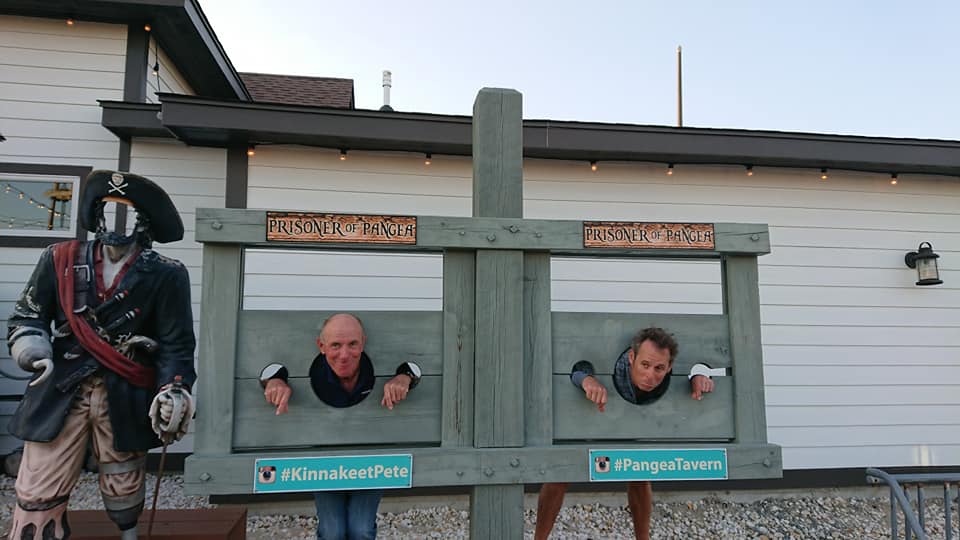
Team Australia OCS in a Le Mans style start off the beach. Punishment has been administered. Photo by Team Australia Worrell 1000 2019
Hatteras->Kill Devil Hills
Place Team Time
1 Australia 03:33:26
2 Cat in the Hat 04:08:59
*2-minute RDG
3 TCDYC 04:32:02
Kill Devil Hills->Virginia Beach
1 Australia 6:50:51
2 Cat in the Hat 7:51:22
3 TCDYC 8:49:34
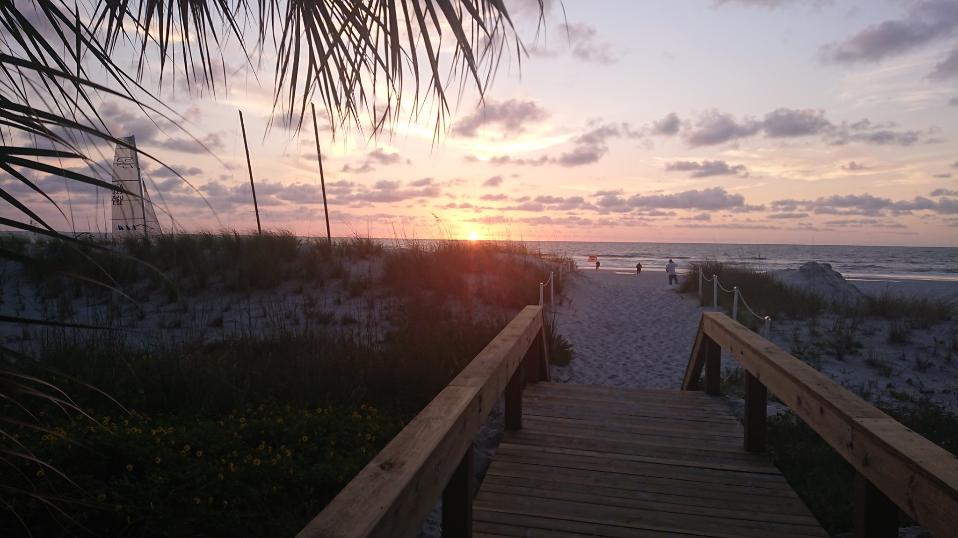
Early start for the 107 NM leg out of Jacksonville to Tybee Island. Photo by Team Australia Worrell 1000 2019